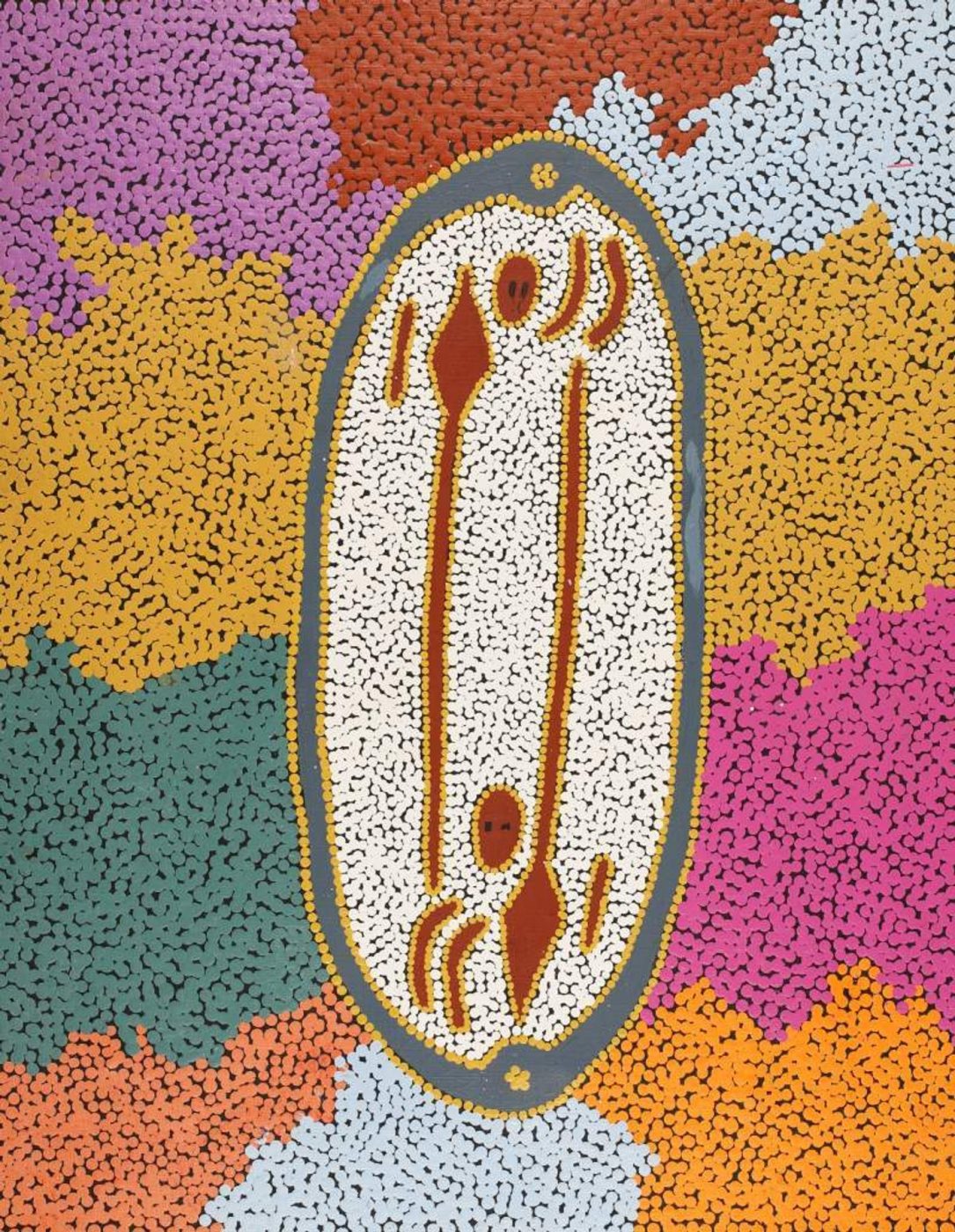Wati-jarra Jukurrpa (Two Men Dreaming)
The ‘kirda’ (owners) of the ‘wati-jarra Jukurrpa’ (two men Dreaming) are Japaljarri/Jungarrayi men and Napaljarri/Nungarrayi women. The painting depicts the journey of a father and son performing initiation ceremonies for young men. Mens’ initiation ceremonies are performed in the hot summer months. In this Dreaming, the men dragged heavy bushes from the sites of Kurlungalinpa, Purrpalala, Yarripirlangu (Newhaven), and Jungarrayiwarnu to Yanjirlpiri (meaning ‘star’ in Warlpiri), a very important ceremonial site west of Yuendumu.
Both men and women are involved in the men’s initiation ceremony. Nungarrayi and Napaljarri women travelled, dancing and singing, behind the men through these places. The women also collected ‘ngalyipi’ (snakevine [Tinospora smilacina]) and other bush foods as they went. This ‘wati-jarra Jukurrpa’ is therefore closely associated with major ‘karnta Jukurrpa’ (womens’ Dreaming) and ‘ngalyipi Jukurrpa’ (snakevine Dreaming) tracks that also travel southwards from Kurlungalinpa to Yanjirlpiri.
The ceremonial importance of Yanjirlpiri cannot be overemphasized; young boys are brought here to be initiated from as far away as Pitjantjatjara country to the south and from Lajamanu far to the north. There is a low hill and a number of ‘mulju’ (water soakages) and ‘warnirri’ (rockholes) at this site. During the ceremony, the men wear ‘jinjirla’ (white feather headdresses) on both sides of their heads. They also have wooden carvings of stars which are laid out on the ground as part of the sand paintings produced for the ‘kurlkurlpa’ (business). Their bodies are painted with white and black circles, representing stars. ‘Witi’ (ceremonial poles) are tied vertically to the legs of the young initiates using ‘ngalyipi’ (snakevine). ‘Witi’ are 10-12 foot long ceremonial poles with ‘ngapiri’ (red river gum [Eucalyptus camaldulensis]) and ‘wurrkali’ (desert bloodwood [Corymbia opaca]) leaves tied to them from top to bottom. The young men dance with the ‘witi’ tied to their shins using ‘ngalyipi’ (snakevine). They dance up and down with slightly bent knees, causing the poles to shake and sway and make noises that scare away spirits. After stopping at Yanjirlpiri for ceremonies, the men and women continued west to Lappi Lappi and to Yininti-walku-walku, near Lake Mackay by the West Australian border.
In contemporary Warlpiri paintings, traditional iconography is used to represent the Jukurrpa, particular sites, and other elements. In paintings of this Dreaming, concentric circles are often used to represent the ‘yanjirlpiri’ (stars) painted on the men’s bodies. Straight lines are frequently used to represent the ‘witi,’ while sinuous lines are often used to represent the ‘ngalyipi’ (snakevine).
